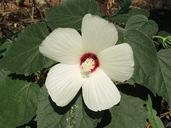Taxon Report
Hibiscus lasiocarpos Cav. var. occidentalis (Torr.) A. Graywoolly rose-mallow |
 © 2020 Steven Perry |
Taxon Summary
Hibiscus lasiocarpos var. occidentalis, commonly known as woolly rose-mallow, is a perennial rhizomatous herb (emergent) in the Malvaceae that is found only in California. It occurs within Marshes and swamps, growing at elevations from 0 to 120 meters. Hibiscus lasiocarpos var. occidentalis is ranked 1B.2, Plants Rare, Threatened or Endangered in California and Elsewhere; Moderately threatened in California.Classification
|
Scientific Name: |
Hibiscus lasiocarpos Cav. var. occidentalis (Torr.) A. Gray |
|
Common Name: |
woolly rose-mallow |
| Family: | Malvaceae |
| Element Code: | PDMAL0H0R3 |
| USDA Plants Symbol: | |
|
Synonyms/Other Names: |
|
Ecology and Life History
| Lifeform: | perennial rhizomatous herb (emergent) |
| Blooming Period: Jun-Sep | Jun-Sep |
| Elevation: | 0-120 (0-395) |
| General Habitats: | Marshes and swamps |
| Microhabitat: | |
| Microhabitat Details: | Often in riprap on sides of levees. |
Conservation Status
| CA Rare Plant Rank: | 1B.2 |
| Global Rank: | G5T3 |
|
State Rank: |
S3 |
| State List: | None |
| Fed List: | None |
| Other Status: | BLM_S; SB_CalBG/RSABG; SB_UCBG |
|
CRPR Changes: |
|
Occurrence Data from the CNDDB
| Total Occurrences: | 173 |
| Element Occurrence Ranks: | |
| Excellent (A) | 0 |
| Good (B) | 78 |
| Fair (C) | 38 |
| Poor (D) | 16 |
| None (X) | 1 |
| Unknown (U) | 40 |
| California Endemic: True | |
| California Counties and Islands: Name (Code) | |
| Butte (BUT), Colusa (COL), Contra Costa (CCA), Glenn (GLE), Sacramento (SAC), San Joaquin (SJQ), Solano (SOL), Sutter (SUT), Yolo (YOL) | |
| Quads: Name (Quad Code) | |
| Bouldin Island (3812115), Bruceville (3812134), Butte City (3912148), Clarksburg (3812145), Clifton Court Forebay (3712175), Courtland (3812135), Dozier (3812137), Florin (3812144), Gilsizer Slough (3912116), Grays Bend (3812166), Hamlin Canyon (3912166), Holt (3712184), Isleton (3812125), Jersey Island (3812116), Knights Landing (3812176), Liberty Island (3812136), Llano Seco (3912158), Logandale (3912242), Meridian (3912128), Nelson (3912157), Ord Ferry (3912168), Oroville (3912155), Paradise West (3912176), Pennington (3912137), Richardson Springs (3912177), Rio Vista (3812126), Sacramento West (3812155), Sanborn Slough (3912138), Shippee (3912156), Stockton West (3712183), Sutter Buttes (3912127), Sutter Causeway (3812186), Terminous (3812114), Thornton (3812124), Tisdale Weir (3912117), Verona (3812175), West of Biggs (3912147), Woodward Island (3712185) | |
Threat List Data from the CNDDB
| Threat List Total: | 19 | |
| EOs with Threat Listed: | Total EOs | % of EOs |
| 91 | 53 % | |
| Waterway bank protection/maintenance | 36 | 20% |
| Recreational use (non-ORV) | 31 | 17% |
| Other | 25 | 14% |
| Agriculture | 19 | 10% |
| Erosion/runoff | 19 | 10% |
| Development | 17 | 9% |
| Biocides | 16 | 9% |
| Improper burning regime | 14 | 8% |
| Non-native plant impacts | 10 | 5% |
| Altered flood/tidal/hydrologic regime | 10 | 5% |
| Grazing | 6 | 3% |
| Road/trail construction/maint. | 6 | 3% |
| Mining | 3 | 1% |
| ORV activity | 1 | 0% |
| Surface water diversion | 1 | 0% |
| Wood cutting or brush clearing | 1 | 0% |
| Foot traffic/trampling | 1 | 0% |
| Dam/Inundation | 1 | 0% |
| Degraded water quality | 1 | 0% |
Notes
| Most occurrences are very small. Seriously threatened by habitat disturbance, development, agriculture, recreational activites, and channelization of the Sacramento River and its tributaries. Also threatened by weed control measures and erosion. Possibly threatened by trail maintenance. See Madroño 56(2):104-111 for revised taxonomy. |
|
Threats: |
|
Taxonomy: |
Citation
California Native Plant Society, Rare Plant Program. 2025. Rare Plant Inventory (online edition, v9.5.1). Website https://www.rareplants.cnps.org [accessed 25 December 2025].